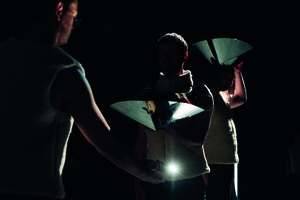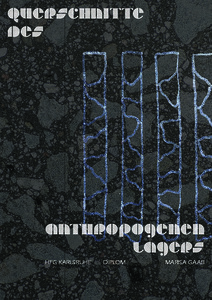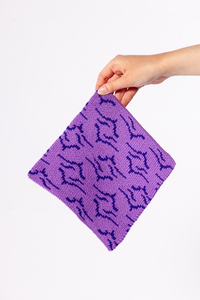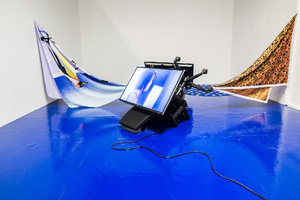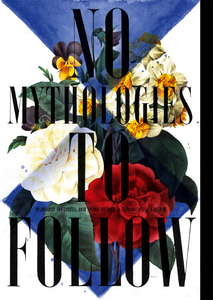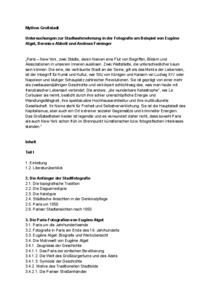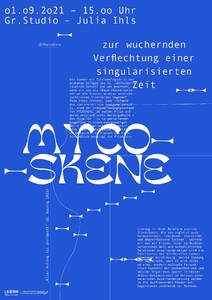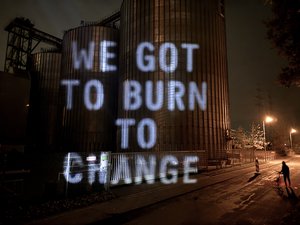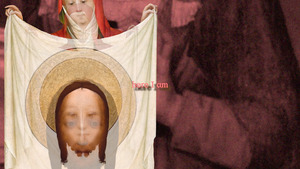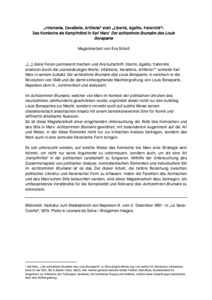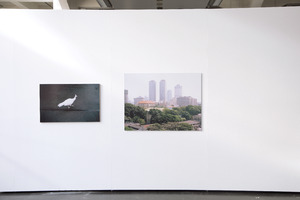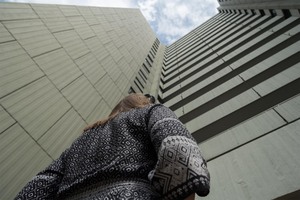Nichts, was uns passiert oder Genügend Anlass zur Erhebung der öffentlichen Klage
Benachbarte Sets (47)Alle Zusammenhänge anzeigen
Diese Sets wurden den gleichen Sets hinzugefügt wie das ausgewählte Set.
47 Inhalte
- Seite 1 von 4
Reflecting Bodies
- Titel
- Reflecting Bodies
- Titel (en)
- Reflecting Bodies
- Untertitel
- A space where a physical phenomenon meets a personal fascination
- Untertitel des Projekts/Werks (en)
- A space where a physical phenomenon meets a personal fascination
- Autor/in
- Beschreibung (de)
- „Reflektierende Körper“ ist eine interaktive Installation, bei der das physikalische Phänomen der Lichtreflexionen auf eine persönliche Faszination für diese trifft. Im Fokus stehen Lichtreflexionen, die vom menschlichen Körper ausgehen und in Verbindung mit dessen Bewegungsabläufen entstehen.
Hauptbestandteil der Installation ist eine Serie von vier Metallobjekten, die wie Schmuckstücke am Körper getragen werden und mit Wasser gefüllt sind. Sie dienen als Reflexionsflächen und geben auf subtile Art und Weise die Präsenz der Menschen im Raum wieder, während sich dieser in eine lebendige und dynamische Lichtinstallation verwandelt.
Ursprung der Arbeit ist die Auseinandersetzung mit dem Thema "natürliches Licht" und dessen Bedeutung für den Menschen. Die allgemeine Faszination und evolutionsbedingte Abhängigkeit der Menschheit von der Sonne findet sich in nahezu allen Kulturen wieder und bildet die Inspirationsquelle für die Formensprache der Objekte und die Gestaltung des Raums.
- „Reflektierende Körper“ ist eine interaktive Installation, bei der das physikalische Phänomen der Lichtreflexionen auf eine persönliche Faszination für diese trifft. Im Fokus stehen Lichtreflexionen, die vom menschlichen Körper ausgehen und in Verbindung mit dessen Bewegungsabläufen entstehen.
- Beschreibung (en)
- "Reflecting Bodies" is an interactive installation in which the physical phenomenon of light reflections meets a personal fascination for them. The focus is on light reflections that originate from the human body and arise in connection with its movements.
The main component of the installation is a series of four metal objects worn like jewellery pieces on the body and filled with water. They serve as reflecting surfaces and subtly mirror the presence of people in space while it transforms into a vibrant and dynamic light installation.
The origin of the work lies in the study of natural light and its importance for human beings. The general fascination and evolutionary dependence of mankind on the sun can be found in almost all cultures and forms the source of inspiration for the design language of the objects and the space.
- "Reflecting Bodies" is an interactive installation in which the physical phenomenon of light reflections meets a personal fascination for them. The focus is on light reflections that originate from the human body and arise in connection with its movements.
- Kategorie
- Typ des Projekts/Werks
- Schlagworte
- Datierung
- 27.04.2023
- Mitwirkende
- Dank an
- Material
- Technik/Verfahren/Formate
- Metallverarbeitung
- Ort: Institution
- Ort
- Großes Studio
- Stadt
- Land
- Internetlinks
- Titel
- Reflecting Bodies
- Projektleiter/in
- Semester
- Studiengang
- Typ der Abschlussarbeit
- Importiert am
- 06.10.2024
- Übergeordnete Sets
- 2
- Set enthält
- 0 9
Querschnitte des anthropogenen Lagers
- Titel
- Querschnitte des anthropogenen Lagers
- Titel (en)
- Cross-sections of the anthropogenic material stock
- Autor/in
- Beschreibung (de)
- Die Arbeit "Querschnitte des anthropogenen Lagers" setzt sich konzeptionell und praktisch mit der Wiederverwendung von Bauschutt auseinander.
Ein Großteil des in Deutschland aufkommenden Abfalls entsteht im Bausektor in Form von mineralischem Bauschutt und wird meist nur in abgewerteter Form wieder in den Kreislauf eingebracht.
Durch das Besuchen verschiedener Baustellen und Deponien, das Dokumentieren, Sammeln, Sortieren, und Fotografieren der vorgefundenen Materialien und Formen, wurden die noch vorhandenen formalen und optischen Qualitäten des anfallenden Materials analysiert, ergründet und Konzepte entwickelt, wie diese wieder im gleichen Bereich ihres Ursprungs Verwendung finden können.
Dabei wurden durch Querschnitte durch das Material die schon vorhandenen Qualitäten, wie die zylindrische Form von Bohrkernen oder die Terrazzo-Optik im Inneren von Betonbrocken, zum Vorschein gebracht, betont und in einen nutzbaren Kontext gesetzt. Die entstandenen Materialscheiben können durch verschiedene Verbindungstechniken als architektonische Halbzeuge genutzt und in Wandpaneele, Fliesen oder Fassadenelemente eingebracht werden.
- Die Arbeit "Querschnitte des anthropogenen Lagers" setzt sich konzeptionell und praktisch mit der Wiederverwendung von Bauschutt auseinander.
- Beschreibung (en)
- The work "Cross-sections of the anthropogenic material stock" deals conceptually and practically with the reuse of construction waste.
A large part of the waste generated in Germany is produced in the construction sector in the form of mineral building rubble and is usually only recycled in a downgraded form.
By visiting various construction sites and landfills, documenting, collecting, sorting and photographing the materials and shapes found, the remaining formal and visual qualities of the accumulated material were analysed, explored and concepts were developed on how they could be reused in the same area of their origin.
The existing qualities, such as the cylindrical shape of drill cores or the terrazzo look inside chunks of concrete, were brought to light, emphasised and placed in a usable context by making cross-sections through the material. The resulting material discs can be used as architectural semi-finis.
- The work "Cross-sections of the anthropogenic material stock" deals conceptually and practically with the reuse of construction waste.
- Kategorie
- Typ des Projekts/Werks
- Schlagworte
- Datierung
- 30.10.2023
- Titel
- Querschnitte des anthropogenen Lagers
- Projektleiter/in
- Semester
- Studiengang
- Typ der Abschlussarbeit
- Importiert am
- 27.05.2024
- Übergeordnete Sets
- 4
- Set enthält
- 0 23
Path Tiles
- Titel
- Path Tiles
- Titel (en)
- Path Tiles
- Untertitel
- Knitting Coordinates into Patterns
- Untertitel des Projekts/Werks (en)
- Knitting Coordinates into Patterns
- Autor/in
- Beschreibung (de)
- Unsere Bewegungen können wie eine Performance begriffen werden, wie etwas Flüchtiges, das nur im Moment existiert und nach der Vollendung weder sichtbar noch fassbar ist. Nur die Erinnerungen an das Erlebte bleiben als Spuren der Bewegung in unserem Geist erhalten. Path Tiles nutzt GPS-Daten, um diese besonderen Momente individueller Erfahrung einzufangen und in Form von Mustern in die physische Welt des sicht- und tastbaren Textils zu übertragen. Es entsteht eine tiefe Bindung zwischen Mensch und Objekt.
Jedes Muster steht für eine Reise, für eine Erfahrung. Dabei ist es egal, ob es sich um einen Spaziergang in der Natur, eine Reise in ein fernes Land oder einen wiederkehrenden Weg des Alltags handelt. Die daraus entstehenden Muster erzählen von den Gefühlen und Begegnungen, von dem Gesehenen und dem Erlebten und erinnern uns an das, was uns ausmacht.
Mit der Path Tiles Website habe ich ein Werkzeug entwickelt, um diese Reisen in Form von GPS-Daten in strickbare Muster zu verwandeln. Ich habe die Website so gestaltet, dass die Ästhetik des Musters durch zusätzliche Verschiebung, Verzerrung und Spiegelung individualisiert werden kann. Dies stellt außerdem sicher, dass Menschen mit der gleichen Strecke trotzdem persönliche Muster erstellen können. Das entstandene Muster wird dann in Form eines gestricktes Objekts zum Leben erweckt und wird zur materialisierten persönlichen Erfahrung. Durch die Einbeziehung des Nutzers in den Gestaltungsprozess entsteht eine weitere Ebene der Bindung zwischen Mensch und Objekt.
Für das Diplom habe ich exemplarisch fünf Objekte gestaltet, die mit diesen Mustern personalisiert werden können. Das Design der Objekte konzentriert sich darauf, das Reisen oder das „unterwegs sein“ in verschiedenen Situationen zu erleichtern. In diesem Prozess ist ein Schal mit Taschen, ein Umhang, der gleichzeitig als Decke genutzt werden kann, eine Tasche, die zugleich ein Kissen ist, eine Balaklava mit Ohrenschützern und ein Nackenkissen mit Rückenstütze und Taschen in den verlängerten Seitenteilen entstanden.
Für die finale Herstellung der Objekte haben fünf Personen die GPS-Daten verschiedener Routen verwendet um ihre persönlichen Muster auf der Path Tiles Website zu erstellen. Jedes der Objekte wurde zu einer Person, einer Reise, einem Muster zugeordnet und entsprechend produziert. Die fertigen Objekte sind die materialisierten Erfahrungen und Erinnerungen dieser Menschen.
Begleitend zu dieser Arbeit habe ich mit der Sammlung von Reisen in Form von Geschichten und Mustern begonnen. Hierbei ist ein kleines Booklet entstanden, das die Beiträge von 19 Menschen beinhaltet. Sie alle haben eine Erinnerung von einer Reise in Form von Text und Muster mit mir geteilt.
- Unsere Bewegungen können wie eine Performance begriffen werden, wie etwas Flüchtiges, das nur im Moment existiert und nach der Vollendung weder sichtbar noch fassbar ist. Nur die Erinnerungen an das Erlebte bleiben als Spuren der Bewegung in unserem Geist erhalten. Path Tiles nutzt GPS-Daten, um diese besonderen Momente individueller Erfahrung einzufangen und in Form von Mustern in die physische Welt des sicht- und tastbaren Textils zu übertragen. Es entsteht eine tiefe Bindung zwischen Mensch und Objekt.
- Beschreibung (en)
- Movement is like a performance, something momentous becoming invisible and untouchable as soon as it is complete. Only the memories of the experience remain as traces of the movement in our minds. Path Tiles captures these valuable moments of individual experiences and transfers them into the physical world of visible and tactile textiles, creating a deep relationship between person and object.
Each pattern represents a journey, an experience. It doesn't matter whether it's a walk in nature, a trip to a distant country, or a repeating path in everyday life. The resulting patterns tell of the emotions evoked by landscapes, the lessons learned along the way and the power of the journey to shape our lives.
With the Path Tiles website, I have developed a tool to transform these journeys into knitable patterns using GPS data. I designed the website so that the aesthetics of the pattern can be individualized through shifting, distorting, and mirroring. This ensures that even people with the same route can create personal patterns. The resulting pattern is then brought to life in the form of a knitted object, becoming a materialized personal experience. By involving the user in the design process, an additional layer of connection between person and object is created.
For my diploma, I have designed five objects that can be personalized with these patterns. The design of these objects focuses on making travelling or being "on the go" more comfortable. This process has resulted in the creation of a scarf with pockets, a cape that can also be used as a blanket, a bag that doubles as a pillow, a balaclava with ear cushions, and a neck pillow with back support and pockets in the extended side parts.
For the final production of the objects, five people used the GPS data of different routes to create their personal patterns on the Path Tiles website. Each of the objects was assigned to a person, a journey, a pattern, and then produced accordingly. The finished objects are the materialized experiences and memories of these people.
Accompanying this work, I have started collecting journeys in the form of stories and patterns. This resulted in a small booklet that includes contributions from 19 people. They all shared a memory of a journey in the form of text and pattern with me.
- Movement is like a performance, something momentous becoming invisible and untouchable as soon as it is complete. Only the memories of the experience remain as traces of the movement in our minds. Path Tiles captures these valuable moments of individual experiences and transfers them into the physical world of visible and tactile textiles, creating a deep relationship between person and object.
- Kategorie
- Typ des Projekts/Werks
- Schlagworte
- Datierung
- April 2024
- Mitwirkende
- Dank an
- Material
- Ort: Institution
- Internetlinks
- Bemerkungen
- Die Diplomarbeit wurde von Prof. Wieki Somers und Prof. Céline Condorelli betreut.
- Titel
- Path Tiles
- Projektleiter/in
- Semester
- Studiengang
- Typ der Abschlussarbeit
- Importiert am
- 28.05.2024
- Übergeordnete Sets
- 4
- Set enthält
- 0 42
Oberfläche schwarz/blau/grün
- Titel
- Oberfläche schwarz/blau/grün
- Titel (en)
- Surface Black/Blue/Green
- Autor/in
- Beschreibung (de)
- Bei der 2-Kanal-Videoinstallation „Oberfläche schwarz/blau/grün“ zum Thema Migration werden zwei Situationen betrachtet und einander gegenübergestellt: Migration von einem Land in ein anderes und Migration auf einen anderen Planeten.
- Beschreibung (en)
- The two-channel video installation is about migration, in which two situations are considered and contrasted: migration from one country to another and migration to another planet.
- Kategorie
- Schlagworte
- Titel
- Oberfläche schwarz/blau/grün
- Projektleiter/in
- Semester
- Studiengang
- Typ der Abschlussarbeit
- Importiert am
- 01.08.2024
- Übergeordnete Sets
- 1
- Set enthält
- 1 10
No Mythologies To Follow
- Titel
- No Mythologies To Follow
- Autor/in
- Beschreibung (de)
- "No Mythologies To Follow" zeigt Blumenarrangements für die neun Kulturgüter der Stadt Karlsruhe, die unter Schutz der Haager Konvention stehen.
Die Konvention ist ein völkerrechtlicher Vertrag, der auf Grund der Erfahrungen vorangegangener Weltkriege durch die UNESCO (United Nations Educational, Scientific and Cultural Organization) im Jahr 1954 ins Leben gerufen wurde. Sie stellt (un)bewegliche
Kulturgüter im bewaffneten Konfliktfall unter Schutz. Das heißt, die gelisteten Gebäude dürfen im Kriegsfall von Mitgliedsstaaten nicht geplündert oder attackiert werden, da „jede Schädigung von Kulturgut, gleichgültig welchem Volke es gehört, eine Schädigung des kulturellen Erbes der ganzen Menschheit bedeutet.“ Die Auswahlkriterien für schützenswertes Kulturgut sind dabei nicht immer klar nachzuvollziehen und zeigen, dass Kultur und ihre Bewertung stets an die jeweilige Gesellschaft und ihr Zeitverständnis gebunden ist. Nach der Haager Konvention gibt es Kulturgüter deren „Erhaltung (…) für alle Völker der Welt von großer Bedeutung ist.“
Die Blumenarrangements werden in der Ausstellung zu Akteuren, die für einen anderen Umgang mit Kulturgut stehen. Durch sie wird Vergänglichkeit artikuliert.
Zitate aus: Konvention zum Schutz von Kulturgut bei bewaffneten Konflikten – Haager Konvention vom 14. Mai 1954.
- "No Mythologies To Follow" zeigt Blumenarrangements für die neun Kulturgüter der Stadt Karlsruhe, die unter Schutz der Haager Konvention stehen.
- Beschreibung (en)
- “No Mythologies To Follow” shows flower arrangements for the nine cultural assets of the city of Karlsruhe that are protected by the Hague Convention.
The Convention is a treaty under international law that was brought into being by UNESCO (United Nations Educational, Scientific and Cultural Organization) in 1954 as a result of the experiences of previous world wars. It provides (in)movable
cultural property under protection in the event of armed conflict. This means that the listed buildings may not be looted or attacked by member states in the event of war, as “any damage to cultural property, regardless of the people to whom it belongs, means damage to the cultural heritage of all mankind.” The selection criteria for cultural property worthy of protection are not always clear and show that culture and its evaluation are always linked to the respective society and its understanding of the times.
is bound to the respective society and its understanding of time. According to the Hague Convention, there are cultural assets whose “preservation (...) is of great importance to all peoples of the world.”
In the exhibition, the flower arrangements become actors that stand for a different approach to cultural assets. They articulate transience.
Quotes from: Convention for the Protection of Cultural Property in the Event of Armed Conflict - Hague Convention of May 14, 1954.
- “No Mythologies To Follow” shows flower arrangements for the nine cultural assets of the city of Karlsruhe that are protected by the Hague Convention.
- Kategorie
- Typ des Projekts/Werks
- Schlagworte
- Mitwirkende
- Dank an
- Harald Bogdan
- Michael Clegg
- Anja Dorn
- Pham Minh Duc
- Friedemann Dupelius
- Lotte Effinger
- Susan Funk
- Hasan Halilovic
- Korbinian Herlein
- Burkhard Hoth
- Erika Hoth
- Katharina Hoth
- Achim Kaltwasser
- Wilfried Kuehn
- Barbara Kuon
- Gisbert Laaber
- Armin Linke
- Henrike Mall
- Isabel Mehl
- Nicolas Rauch
- Gerald Reinhardt
- Christiane Riedel
- Thomas Rustemeyer
- Martina Stern
- Felicitas Wetzel
- Tobias Wootton
- Emre Yilmaz
- Ort: Institution
- Ort
- Ausstellungsraum EG
- Stadt
- Beteiligte Institution(en)
- Titel
- No Mythologies To Follow
- Semester
- Studiengang
- Typ der Abschlussarbeit
- Importiert am
- 30.07.2024
- Übergeordnete Sets
- 3
- Set enthält
- 6 6
Mythos Großstadt
- Titel
- Mythos Großstadt
- Titel (en)
- The myth of the big city
- Untertitel
- Untersuchungen zur Stadtwahrnehmung in der Fotografie am Beispiel von Eugène Atget, Berenice Abbott und Andreas Feininger
- Autor/in
- Beschreibung (de)
- „Paris – New York, zwei Städte, deren Namen eine Flut von Begriffen, Bildern und Assoziationen in unserem Inneren auslösen. Zwei Weltstädte, die unterschiedlicher kaum sein können. Die eine, die verträumte Stadt an der Seine, gilt als das Mekka der Liebenden, ist der Inbegriff für Kunst und Kultur, war Sitz von Königen und Kaisern wir Ludwig XIV. oder Napoleon und blutiger Schauplatz zahlreicher Revolutionen. Sie ist geprägt von einer mehr als zweitausendjährigen Geschichte und verkörpert schlichtweg das, was man heute mit französischer Lebensart verbindet. Die andere, 'die wunderbare Katastrophe', wie Le Corbusier sie nennt, besticht durch ihre schier unerschöpfliche Energie und Wandlungsfähigkeit, ihre spektakuläre Hochhausarchitektur und ihre multikulturelle Gesellschaft. Ihr Name steht für Freiheit und Selbstverwirklichung. Sie ist die Hauptstadt des Kapitalismus, aber auch ein Ort extremer sozialer Gegensätze und krimineller Energien.
Das Großstadtleben beider ist legendär und es verwundert daher nicht, dass sowohl Paris als auch New York schon früh im Brennpunkt künstlerischen bzw. fotografischen Interesses standen.”
- „Paris – New York, zwei Städte, deren Namen eine Flut von Begriffen, Bildern und Assoziationen in unserem Inneren auslösen. Zwei Weltstädte, die unterschiedlicher kaum sein können. Die eine, die verträumte Stadt an der Seine, gilt als das Mekka der Liebenden, ist der Inbegriff für Kunst und Kultur, war Sitz von Königen und Kaisern wir Ludwig XIV. oder Napoleon und blutiger Schauplatz zahlreicher Revolutionen. Sie ist geprägt von einer mehr als zweitausendjährigen Geschichte und verkörpert schlichtweg das, was man heute mit französischer Lebensart verbindet. Die andere, 'die wunderbare Katastrophe', wie Le Corbusier sie nennt, besticht durch ihre schier unerschöpfliche Energie und Wandlungsfähigkeit, ihre spektakuläre Hochhausarchitektur und ihre multikulturelle Gesellschaft. Ihr Name steht für Freiheit und Selbstverwirklichung. Sie ist die Hauptstadt des Kapitalismus, aber auch ein Ort extremer sozialer Gegensätze und krimineller Energien.
- Beschreibung (en)
- "Paris - New York, two cities whose names trigger a flood of concepts, images and associations within us. Two cosmopolitan cities that could hardly be more different. One, the dreamy city on the Seine, is considered the Mecca of lovers, is the epitome of art and culture, was the seat of kings and emperors such as Louis XIV and Napoleon and the bloody scene of numerous revolutions. It is characterized by more than two thousand years of history and simply embodies what is associated with the French way of life today. The other, 'the marvelous catastrophe', as Le Corbusier called it, captivates with its sheer inexhaustible energy and adaptability, its spectacular high-rise architecture and its multicultural society. Its name stands for freedom and self-realization. It is the capital of capitalism, but also a place of extreme social contrasts and criminal energy.
The big city life of both is legendary and it is therefore not surprising that both Paris and New York were the focus of artistic and photographic interest early on."
- "Paris - New York, two cities whose names trigger a flood of concepts, images and associations within us. Two cosmopolitan cities that could hardly be more different. One, the dreamy city on the Seine, is considered the Mecca of lovers, is the epitome of art and culture, was the seat of kings and emperors such as Louis XIV and Napoleon and the bloody scene of numerous revolutions. It is characterized by more than two thousand years of history and simply embodies what is associated with the French way of life today. The other, 'the marvelous catastrophe', as Le Corbusier called it, captivates with its sheer inexhaustible energy and adaptability, its spectacular high-rise architecture and its multicultural society. Its name stands for freedom and self-realization. It is the capital of capitalism, but also a place of extreme social contrasts and criminal energy.
- Kategorie
- Typ des Projekts/Werks
- Schlagworte
- Datierung
- 2003
- Sprache
- Ort: Institution
- Stadt
- Titel
- Mythos Großstadt
- Projektleiter/in
- Studiengang
- Typ der Abschlussarbeit
- Archiv-Signatur
- HfG HS 2003 02
- Externes Archiv
- Importiert am
- 16.06.2024
- Übergeordnete Sets
- 2
- Set enthält
- 0 2
MYCOSKENE
- Titel
- MYCOSKENE
- Titel (en)
- Mycoskene
- Untertitel
- Zur wuchernden Verflechtung einer singularisierten Zeit
- Untertitel des Projekts/Werks (en)
- Or on the rampant interweaving of a singularized time
- Autor/in
- Beschreibung (de)
- MYCOSKENE ist eine material-theoretische Verflechtung rund um das Thema Mycelium, dem unterirdischen Hyphengeflecht der Pilze. Ob als sozio-philosophische Metapher, Bau- und Gestaltungsmaterial oder in Form einer multi-medialen Rauminstallation – in ihrer Arbeit folgte die Szenografin und Konzepterin Julia Ihls über 8 Monate den fein verwobenen Strukturen jener Organismen, die durch ihre eigene Zeitlichkeit und Qualitäten zu maßgeblichen Co-Gestaltenden wurden.
- Beschreibung (en)
- MYCOSKENE is a material-theoretical interweaving around the theme of mycelium, the subterranean network of hyphae of fungi. Whether as a socio-philosophical metaphor, building and design material or in the form of a multi-media spatial installation - in her work, scenographer and conceptual designer Julia Ihls followed the finely interwoven structures of these organisms for over 8 months, which became decisive co-creators through their own temporality and qualities.
- Kategorie
- Typ des Projekts/Werks
- Schlagworte
- Datierung
- 01.09.2021 - 03.09.2021
- Mitwirkende
- Sprache
- Ort: Institution
- Ort
- Großes Studio
- Stadt
- Land
- Internetlinks
- Walkthrough Video: https://vimeo.com/653230334
Doku Film:
Instagram: @mycoskene https://www.instagram.com/mycoskene/?hl=de
Website: https://mycoskene-.hotglue.me/
- Walkthrough Video: https://vimeo.com/653230334
- Titel
- MYCOSKENE
- Projektleiter/in
- Semester
- Studiengang
- Typ der Abschlussarbeit
- Importiert am
- 14.12.2023
- Übergeordnete Sets
- 3
- Set enthält
- 0 11
Letters of Dissent
- Titel
- Letters of Dissent
- Titel (en)
- Letters of Dissent
- Autor/in
- Beschreibung (de)
- Mein Diplomprojekt mit dem Titel „LETTERS OF DISSENT“ hatte zum Ziel, praktische und zugängliche Mittel des nächtlichen Protests zu erforschen. Dieses Projekt, das sich mit der Wechselbeziehung von Geschichtenerzählen und Punk-Einflüssen befasst, soll durch künstlerische Intervention ein Schlaglicht auf soziale und politische Themen werfen. Es handelt sich um selbst geschriebene Erzählungen, die in einer auf optimale Lesbarkeit ausgelegten Schriftart verfasst sind. Die Einfachheit der verwendeten Technik sorgt für Tragbarkeit und Zugänglichkeit. Das Engagement der Gemeinschaft ist integraler Bestandteil des Werks, das sowohl als Lasercut- als auch als 3D-Druckversion vorliegt und als Open-Source-Initiative zur Verfügung gestellt wird. Die Gesamtästhetik ist von auffallender Helligkeit geprägt und schafft eine visuell beeindruckende und deutlich wahrnehmbare Präsenz. Neben der Hauptdiplomarbeit ist es erforderlich, neuere Arbeiten in einer Ausstellung zu präsentieren, in der sorgfältig ausgewählte Projekte vorgestellt werden. In dem Bemühen, das Ausstellungsdesign auf das übergreifende Thema des Diplomprojekts abzustimmen, zielte der Designansatz darauf ab, wesentliche Prinzipien wie Zugänglichkeit, Abfallminimierung und eine ephemere Pop-up-Sensibilität zu verkörpern.
- Beschreibung (en)
- My diploma project titled "LETTERS OF DISSENT," aimed to explore practical and approachable means of protesting during the nighttime. Delving into the interrelation of storytelling and punk influence, this project seeks to cast a spotlight on social and political subjects through artistic intervention. It involves self-written narratives, utilising a font designed for optimal readability. The simplicity of the technique employed ensures portability and accessibility. Community engagement is integral, using both a lasercut and 3D-print version of the work, which is made available as an open-source initiative. The overall aesthetic is marked by striking brightness, creating a visually impactful and overtly noticeable presence. In addition to the primary diploma project, it is required to showcase recent works in an exhibition, featuring carefully chosen projects. In an effort to align the exhibition design with the overarching theme of the diploma project, the design approach aimed to encapsulate essential principles such as accessibility, waste minimisation, and an ephemeral, pop-up sensibility.
- Kategorie
- Schlagworte
- Datierung
- 03.11.2023
- Titel
- Letters of Dissent
- Projektleiter/in
- Semester
- Studiengang
- Typ der Abschlussarbeit
- Importiert am
- 30.10.2024
- Übergeordnete Sets
- 3
- Set enthält
- 0 11
I used to think that I was made of Stone
- Titel
- I used to think that I was made of Stone
- Titel (en)
- I used to think that I was made of Stone
- Autor/in
- Beschreibung (de)
- In der multimedialen Installation „I used to think that I was made of Stone“ werden die Besuchenden Zeug*innen eines nächtlichen Treffens von vier Personen, die nur durch ihre Stimmen präsent sind. Sie unterhalten sich über merkwürdige Objekte in ihrer greifbaren Nähe, führen nebensächliche Gespräche und verbringen einen Abend damit, Musik zu hören und zu tanzen. Ihre Körper bleiben in der Installation unsichtbar, die Objekte im Raum werden zu Spuren.
Durch das Sammeln, neu Arrangieren und Kombinieren von religiösen, (pop-)kulturellen und selbst produzierten Fragmenten im Raum verhandelt „I used to think that I was made of Stone”, wie Lücken und Ausschmückungen unsere Realitäten in der Gegenwart formen und welche Geschichten und Nacherzählungen sie produzieren. Dabei fragt es nach Autor*innenschaft und den Übersetzer*innen, die das Produzierte wortwörtlich über-setzen, weiter-tragen und fort-spinnen und somit stetig weiter produzieren. Sie bestimmen die Stofflichkeit der Geschichte, knoten die Fäden der Ausschmückungen, brennen Löcher und Lücken in das Gewebe und geben es weiter.
- In der multimedialen Installation „I used to think that I was made of Stone“ werden die Besuchenden Zeug*innen eines nächtlichen Treffens von vier Personen, die nur durch ihre Stimmen präsent sind. Sie unterhalten sich über merkwürdige Objekte in ihrer greifbaren Nähe, führen nebensächliche Gespräche und verbringen einen Abend damit, Musik zu hören und zu tanzen. Ihre Körper bleiben in der Installation unsichtbar, die Objekte im Raum werden zu Spuren.
- Beschreibung (en)
- In the multimedia installation “I used to think that I was made of Stone”, visitors witness a nighttime meeting of four people who are only present through their voices. They talk about strange objects within reach, have trivial conversations, and spend an evening listening to music and dancing. Their bodies remain invisible in the installation, while the objects in the room become traces of their presence.
By collecting, rearranging and combining religious, (pop) cultural and self-produced fragments in the space, “I used to think that I was made of Stone” explores how gaps and embellishments shape our realities in the present, and what stories they generate or retell. In doing so, it questions authorship and the role of translators, who literally translate, carry forward, and elaborate on what has already been produced, thus continuing the production process. They determine the material nature of the story, tie the threads of embellishment, burn holes and gaps into the fabric and pass it on.
- In the multimedia installation “I used to think that I was made of Stone”, visitors witness a nighttime meeting of four people who are only present through their voices. They talk about strange objects within reach, have trivial conversations, and spend an evening listening to music and dancing. Their bodies remain invisible in the installation, while the objects in the room become traces of their presence.
- Kategorie
- Typ des Projekts/Werks
- Schlagworte
- Datierung
- Februar 2023
- Mitwirkende
- Sprache
- Abmessungen
- „face imprint” (Textil, Wachs, 63 x 54 cm); „about veronica” (Textil, Stickerei, 84 x 67 cm); „about the cloth” (Projektion, 12 Seiten); „I used to think” (HD-video, Audio, 13:46 min); „toad” (Ton, Wachs, 11 x 13 cm); „wax and stones” (Wachs, Schwelle TV HIFI, 20 x 6 cm); „wax and stone” (Wachs, Stein, 40 x 40 x 10 cm); „everyone” (Reader, 9,5 x 15,2 cm, 36 Seiten); „glasses” (4 Kristallgläser, 5 x 7 cm, Wachs); „jumping rope” (Seil, 2 m); „gestalt mit großem hut” (Keramik, 6 x 7 cm); „fabric n°1” (Textil, Wachs, 57 x 41cm); „fabric n°2” (Textil, Wachs, 60 x 45 cm); „y” (Textil, Wachs, 25 x 15 cm); „woven temple, hidden cocoon #3” (Playlist, 43 Tracks); „wine fountain” (Glas, Pumpe, Wein, 20 x 20 x 110 cm); „cushion” (Textil, Watte, Stickerei, 15 x 15 cm)
- Ort: Institution
- Stadt
- Land
- Titel
- I used to think that I was made of Stone
- Projektleiter/in
- Semester
- Studiengang
- Typ der Abschlussarbeit
- Importiert am
- 25.06.2024
- Übergeordnete Sets
- 3
- Set enthält
- 0 14
„Infanterie, Cavallerie, Artillerie“ statt „Liberté, égalite, fraternité“: Das Komische als Kampfmittel in Karl Marx' "Der achtzehnte Brumaire des Louis Bonaparte"
- Titel
- „Infanterie, Cavallerie, Artillerie“ statt „Liberté, égalite, fraternité“: Das Komische als Kampfmittel in Karl Marx' "Der achtzehnte Brumaire des Louis Bonaparte"
- Autor/in
- Beschreibung (de)
- Im Aufsatz „Der achtzehnte Brumaire des Louis Bonaparte“, welcher von Karl Marx im Kontext der politischen Unruhen des neunzehnten Jahrhunderts geschrieben wurde, ergründet dieser nicht nur den Aufstieg Louis Bonapartes zur Macht, sondern verwebt auch auf subtile Weise seinen charakteristisch analytischen Ansatz mit einem bemerkenswerten Sinn für Komik und raffinierte stilistische Nuancen.
So ist diese Magisterarbeit einer eingehenden Untersuchung der Rolle des Komischen und des Stils in Marx' „Achtzehnten Brumaire“ gewidmet, mit besonderem Augenmerk auf die Art und Weise, in der diese Elemente nicht nur zur kritischen Analyse beitragen, sondern das Werk auch in eine sinnvolle literarische Form bringen.
Es soll untersucht werden, auf welche Weise das Komische bei Marx eine Strategie sein könnte, um nicht nur seine Argumente zu untermauern, sondern auch, um als eine Art ‚Kampfmittel‘ in der politischen Landschaft zu fungieren. Mithilfe der Untersuchung des Zusammenspiels von politischer Analyse, komödiantischen Elementen und individuellem Stil im „Achtzehnten Brumaire“ ist es das Ziel dieser Arbeit, die tiefere Beziehung zwischen politischer Literatur und literarischer Form zu erfassen. Indem die Facetten des Komischen und des Marx'schen Stils beleuchtet werden, wird diese Magisterarbeit dazu beitragen, ein umfassenderes Verständnis für die Komplexität und Relevanz des „Achtzehnten Brumaire“ zu entwickeln.
- Im Aufsatz „Der achtzehnte Brumaire des Louis Bonaparte“, welcher von Karl Marx im Kontext der politischen Unruhen des neunzehnten Jahrhunderts geschrieben wurde, ergründet dieser nicht nur den Aufstieg Louis Bonapartes zur Macht, sondern verwebt auch auf subtile Weise seinen charakteristisch analytischen Ansatz mit einem bemerkenswerten Sinn für Komik und raffinierte stilistische Nuancen.
- Beschreibung (en)
- In the essay “The Eighteenth Brumaire of Louis Bonaparte”, written by Karl Marx in the context of the political turmoil of the nineteenth century, he not only explores Louis Bonaparte's rise to power but also subtly interweaves his characteristically analytical approach with a remarkable sense of comedy and refined stylistic nuance.
Thus, this master thesis is dedicated to an in-depth examination of the role of comedy and style in Marx's “Eighteenth Brumaire”, with particular attention to how these elements not only contribute to critical analysis but also give the work a meaningful literary form.
It will examine how the comic might be a strategy for Marx not only to support his arguments but also to function as a kind of 'means of struggle' in the political landscape. By examining the interplay of political analysis, comedic elements, and individual style in the “Eighteenth Brumaire”, this thesis aims to grasp the deeper relationship between political literature and literary form. By highlighting the facets of comedy and Marx's style, this thesis will help to develop a more comprehensive understanding of the complexity and relevance of the “Eighteenth Brumaire”.
- In the essay “The Eighteenth Brumaire of Louis Bonaparte”, written by Karl Marx in the context of the political turmoil of the nineteenth century, he not only explores Louis Bonaparte's rise to power but also subtly interweaves his characteristically analytical approach with a remarkable sense of comedy and refined stylistic nuance.
- Kategorie
- Typ des Projekts/Werks
- Datierung
- 31.08.2023
- Sprache
- Titel
- „Infanterie, Cavallerie, Artillerie“ statt „Liberté, égalite, fraternité“: Das Komische als Kampfmittel in Karl Marx' "Der achtzehnte Brumaire des Louis Bonaparte"
- Projektleiter/in
- Semester
- Studiengang
- Typ der Abschlussarbeit
- Importiert am
- 31.05.2024
- Übergeordnete Sets
- 5
- Set enthält
- 0 2
Ich hatte vom feeling her ein gutes Gefühl
- Titel
- Ich hatte vom feeling her ein gutes Gefühl
- Autor/in
- Beschreibung (de)
- „Der Weg ist das Ziel“ ist meine Devise. Der Arbeitsprozess ist daher ein wichtiger Teil meines Diploms. Ich zeige Fotos aus unterschiedlichen Teilen der Welt mit sehr unterschiedlichen Bildsprachen. Sie sind Momentaufnahmen aus meinem Blick durch die Kamera. Diese Bilder setze ich in Bezug zueinander, wobei manche Bilder miteinander harmonieren, funktionieren, kommunizieren – andere wiederum nicht. Durch die projizierten Bilder ändern sich die Bezüge und zeigen, dass die Bilder anders kommunizieren, je nachdem, welche Bilder an ihrer Seite sind. Dabei ist die Abfolge der Bilder eine Endlosschleife, und eine Bildkombination einer Wand kehrt immer wieder. Die Betrachtenden sind frei, selbst zu assoziieren, und jeder Blick sieht einen neuen, ganz eigenen Zusammenhang in der Konstellation der Fotografien.
Fotografieausstellung mit 18 Bildern auf Holz und Aludibond und 30 Bildern projiziert auf zwei Beamern.
- „Der Weg ist das Ziel“ ist meine Devise. Der Arbeitsprozess ist daher ein wichtiger Teil meines Diploms. Ich zeige Fotos aus unterschiedlichen Teilen der Welt mit sehr unterschiedlichen Bildsprachen. Sie sind Momentaufnahmen aus meinem Blick durch die Kamera. Diese Bilder setze ich in Bezug zueinander, wobei manche Bilder miteinander harmonieren, funktionieren, kommunizieren – andere wiederum nicht. Durch die projizierten Bilder ändern sich die Bezüge und zeigen, dass die Bilder anders kommunizieren, je nachdem, welche Bilder an ihrer Seite sind. Dabei ist die Abfolge der Bilder eine Endlosschleife, und eine Bildkombination einer Wand kehrt immer wieder. Die Betrachtenden sind frei, selbst zu assoziieren, und jeder Blick sieht einen neuen, ganz eigenen Zusammenhang in der Konstellation der Fotografien.
- Beschreibung (en)
- “The journey is the reward” is my motto. The work process is therefore an important part of my diploma. I show photos from different parts of the world with very different visual languages. They are snapshots from my view through the camera. I place these images in relation to each other, whereby some images harmonize, function and communicate with each other - others do not. The projected images change the references and show that the images communicate differently depending on which images are at their side. The sequence of images is an endless loop and a combination of images on a wall is repeated again and again. Viewers are free to make their own associations and each view sees a new, unique context in the constellation of photographs.
Photography exhibition with 18 pictures on wood and Aludibond and 30 pictures projected on two beamers.
- “The journey is the reward” is my motto. The work process is therefore an important part of my diploma. I show photos from different parts of the world with very different visual languages. They are snapshots from my view through the camera. I place these images in relation to each other, whereby some images harmonize, function and communicate with each other - others do not. The projected images change the references and show that the images communicate differently depending on which images are at their side. The sequence of images is an endless loop and a combination of images on a wall is repeated again and again. Viewers are free to make their own associations and each view sees a new, unique context in the constellation of photographs.
- Kategorie
- Material
- Titel
- Ich hatte vom feeling her ein gutes Gefühl
- Projektleiter/in
- Semester
- Studiengang
- Typ der Abschlussarbeit
- Importiert am
- 30.07.2024
- Übergeordnete Sets
- 1
- Set enthält
- 0 12
HOCHHAUS Audiowalk
- Titel
- HOCHHAUS Audiowalk
- Autor/in
- Beschreibung (de)
- Der HOCHHAUS Audiowalk führt die Teilnehmer*innen an spezifische Orte des Hochhauses der Kaiserallee 15 in Karlsruhe und lässt das Gebäude zum Hauptakteur werden. In neun Audiotracks werden collageartig Texte aus verschiedenen Perspektiven verarbeitet.
- Beschreibung (en)
- The HOCHHAUS audio walk takes participants to specific locations in the high-rise building at Kaiserallee 15 in Karlsruhe, making the building the main protagonist. In nine audio tracks, texts from different perspectives are collaged together.
- Kategorie
- Typ des Projekts/Werks
- Schlagworte
- Datierung
- 20.07.2019
- Mitwirkende
- Dauer
- 55 min
- Ort
- Hochhaus Kaiserallee 15
- Stadt
- Land
- Bemerkungen
- Referenzen:
J.G. Ballard: Hochhaus
EWG Wohnzentrum Kaiserallee Informationsprospekt von 1968
Interviews mit Bewohner*innen der Kaiserallee 15
Interview mit Hausmeister der Kaiserallee 15
George Perec: Träume von Räumen
Unter der Verwendung von:
Magix Music Maker
Mit Sounds und Musik von:
white bicycle
Title: April Sun Playalong
Link: https://www.audiyou.de/beitrag/april-sun-playalong…
(Veränderungen wurden vorgenommen)
Starscade
Title: sfx-radio-static.flac
Link: https://freesound.org/people/Starscade/sounds/3973…
(Veränderungen wurden vorgenommen)
Satuniman
Title: Gramophone
Link: https://freesound.org/people/Setuniman/sounds/1785…
(Veränderungen wurden vorgenommen)
- Referenzen:
- Titel
- HOCHHAUS Audiowalk
- Projektleiter/in
- Semester
- Studiengang
- Typ der Abschlussarbeit
- Importiert am
- 14.06.2024
- Übergeordnete Sets
- 1
- Set enthält
- 0 15
